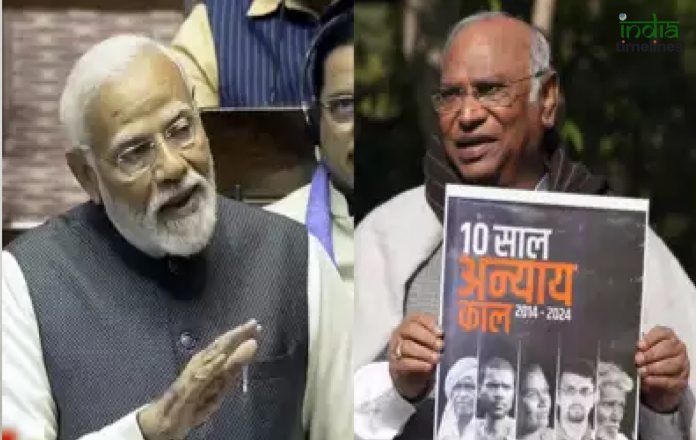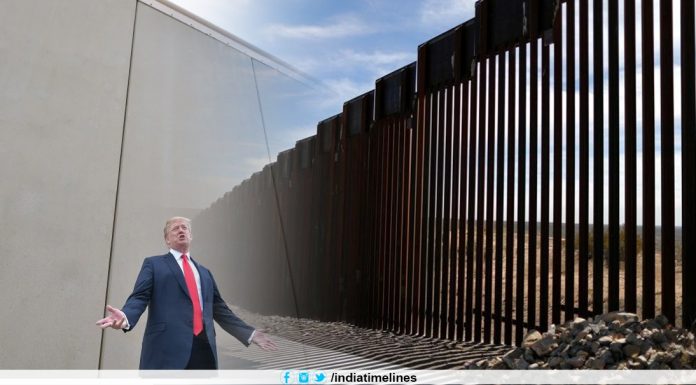
In the intricate tapestry of Indian politics, where rhetoric and symbolism frequently take center stage, Prime Minister Narendra Modi’s recent verbal riposte aimed at Mallikarjun Kharge, a prominent leader of the Congress party, sparked a flurry of discussions and analyses. This verbal exchange unfolded against the backdrop of the Congress party’s release of what they termed a ‘black paper’, a scathing critique of the policies and governance of the Modi administration. However, it was Modi’s cleverly crafted retort, laden with cultural and linguistic symbolism, that captured widespread attention and debate.
The phrase “kaala teeka,” which translates to “black mark” or “black spot,” was the crux of Modi’s response. Beyond its literal meaning, the term carries potent cultural connotations in Indian society. Traditionally, applying a “teeka” or mark, often made of black kohl, is believed to ward off evil spirits or bring good luck. Conversely, a “kaala teeka” signifies something ominous or negative, akin to casting a curse or harbinger of misfortune.
By invoking this phrase, Modi not only countered the Congress’s accusations but also subtly employed a linguistic device to flip the narrative. The choice of words was strategic, tapping into deeply ingrained cultural beliefs and superstitions to portray the Congress party’s allegations as futile attempts to bring ill luck upon his government. Furthermore, the use of colloquial language added an element of relatability, resonating with a broader audience beyond the political elite.
However, the significance of Modi’s ‘kaala teeka’ dig extends beyond mere linguistic wordplay. It serves as a manifestation of the ongoing ideological battle between the Bharatiya Janata Party (BJP) and the Indian National Congress, two stalwarts of Indian politics with contrasting visions for the nation. Modi’s sharp retort not only defended his government’s policies but also underscored the BJP’s narrative of portraying itself as the guardian of Indian cultural values and traditions, contrasting with the Congress party’s alleged disregard for such sentiments.
Moreover, this exchange exemplifies the enduring importance of symbolism and rhetoric in Indian political discourse. In a country where symbolism often carries more weight than substance, politicians frequently resort to symbolic gestures and linguistic nuances to sway public opinion and consolidate their power base. Modi’s adept utilization of such rhetorical devices reflects his mastery of political communication and his ability to connect with the masses on a cultural and emotional level.
In essence, Prime Minister Narendra Modi’s ‘kaala teeka’ remark encapsulates the multifaceted nature of Indian politics, where language, symbolism, and ideology intertwine to shape public perception and influence electoral outcomes. Beyond being a mere verbal retort, it serves as a poignant reminder of the enduring significance of cultural symbolism and linguistic dexterity in the ever-evolving landscape of Indian democracy.
Understanding PM Modi’s ‘Kaala Teeka’ Remark
What is the significance of ‘Kaala Teeka’?
In the rich tapestry of Indian culture, the practice of applying a “kaala teeka,” or a black mark, holds profound significance deeply intertwined with centuries-old beliefs and customs. Rooted in spirituality and folklore, this symbolic act is not merely a cosmetic gesture but a powerful ritual believed to possess protective qualities against malevolent forces and ward off evil influences.
The term “kaala teeka” derives from two Hindi words: “kaala,” meaning black, and “teeka,” referring to a mark or dot. When applied, typically with a small dot of black paste or kohl, it is commonly placed on the forehead, between the eyebrows, a spot known as the “ajna chakra” or the third eye in Hindu tradition. This placement is significant as it is believed to be the center of intuition and spiritual insight, making it an ideal point for invoking protection.
The tradition of applying a kaala teeka traces its origins to ancient Indian mythology and religious practices. In Hinduism, various deities are often depicted adorned with a mark on their foreheads, symbolizing divine power and protection. For example, Lord Shiva, one of the principal deities in Hinduism, is frequently depicted with a vertical mark resembling a third eye, symbolizing his omniscience and spiritual insight. By emulating this divine adornment through the kaala teeka, individuals seek to invoke similar protection and wisdom.
How is it related to Indian politics?
In the intricate tapestry of Indian politics, the concept of “kaala teeka” holds a significant place, serving as a metaphorical emblem for the strategies and dynamics at play within the political landscape. Derived from Hindi, “kaala teeka” translates to “black mark” or “black dot” when taken literally, but its figurative usage carries deeper connotations within the political sphere.
At its core, “kaala teeka” symbolizes the act of deflecting blame or criticism onto others in order to safeguard one’s own reputation or agenda. It is often deployed as a strategic maneuver by political figures and parties to redirect attention away from their own failings or missteps towards their adversaries or rivals. In doing so, they seek to tarnish the reputation or credibility of their opponents, casting them in a negative light while simultaneously bolstering their own image.
This tactic of employing “kaala teeka” in political discourse is emblematic of the cutthroat nature of Indian politics, where rivalries and power struggles are commonplace. In the quest for dominance and influence, politicians often resort to mudslinging and character assassination, utilizing the concept of “kaala teeka” as a potent weapon in their arsenal.
Congress Releases ‘Black Paper’: What Does it Contain?
Overview of the ‘Black Paper’
The ‘Black Paper’ released by the Congress party serves as a comprehensive dossier meticulously outlining a myriad of allegations and critiques directed towards the policies and governance strategies of the Modi-led government. This document stands as a testament to the Congress party’s stance on the socio-political landscape of India, providing a detailed examination of what it perceives as shortcomings, failures, and inadequacies across diverse sectors of governance.
At its core, the ‘Black Paper’ represents a strategic effort by the Congress party to articulate and disseminate its dissenting voice in a structured and impactful manner. Through a meticulous compilation of data, analysis, and commentary, it endeavors to shed light on the perceived discrepancies and lapses in governance that have emerged under the tenure of the Modi administration.
Key allegations against the Modi government
Among the allegations leveled by the Congress are concerns regarding economic slowdown, unemployment, agrarian distress, and erosion of democratic values. The document seeks to portray a narrative of mismanagement and negligence on the part of the ruling BJP.
PM Modi’s Response: ‘Kaala Teeka’ Dig at Mallikarjun Kharge
Analyzing Modi’s choice of words
PM Modi’s use of the ‘kaala teeka’ metaphor in his response to Mallikarjun Kharge’s accusations can be seen as a strategic move to counter the allegations by implying that they are baseless and aimed at deflecting attention from the Congress party’s own shortcomings.
Political implications of the remark
By employing this metaphor, PM Modi not only dismisses the allegations but also seeks to discredit the opposition’s narrative, portraying them as engaging in superstitious or manipulative tactics rather than engaging in substantive debate or critique.
The BJP-Congress Political Dynamics
Brief history of BJP-Congress rivalry
The BJP and Congress have long been at loggerheads in Indian politics, with each party representing contrasting ideologies and agendas. The rivalry between the two parties has often been characterized by intense competition and mutual distrust.
Recent developments and tensions
In recent years, the political landscape in India has witnessed heightened tensions between the BJP and Congress, exacerbated by ideological differences, electoral battles, and competing narratives. The release of the ‘black paper’ and PM Modi’s response are indicative of this ongoing confrontation.
Public Reaction and Media Coverage
Social media response
The exchange between PM Modi and Mallikarjun Kharge has sparked widespread discussion and debate on social media platforms, with users expressing varied opinions and interpretations of the event. Memes, hashtags, and viral posts have contributed to the amplification of the narrative.
Media’s interpretation of the event
Media outlets have provided extensive coverage of the ‘kaala teeka’ remark and its implications, analyzing the political context and implications of PM Modi’s response. Opinions vary, with some pundits praising Modi’s rhetorical skills while others criticize the use of symbolism over substantive discourse.
Conclusion
In the realm of Indian politics, symbolism and rhetoric often play significant roles in shaping public discourse and perception. PM Modi’s ‘kaala teeka’ dig at Mallikarjun Kharge underscores the ongoing tensions between the BJP and Congress, highlighting the competitive nature of Indian politics. As the political landscape continues to evolve, such exchanges serve as reminders of the complexities and nuances inherent in democratic governance.
FAQs
1. What is the significance of PM Modi’s ‘kaala teeka’ remark?
PM Modi’s use of the ‘kaala teeka’ metaphor is a rhetorical device aimed at dismissing allegations leveled against his government by the Congress party.
2. Why did the Congress release a ‘black paper’?
The Congress party released the ‘black paper’ to critique and highlight what they perceive as failures or shortcomings in the policies and governance of the Modi-led government.
3. How has the public reacted to PM Modi’s remark?
Public reactions to PM Modi’s remark have been varied, with some praising his rhetorical skills while others criticizing the use of symbolism over substantive debate.
4. What are the broader implications of the BJP-Congress rivalry?
The rivalry between the BJP and Congress reflects deeper ideological and political divides within Indian society, influencing policy debates and electoral dynamics.
5. How has the media covered the exchange between PM Modi and Mallikarjun Kharge?
Media coverage of the exchange has been extensive, with pundits offering diverse interpretations and analyses of the event’s political significance.

































